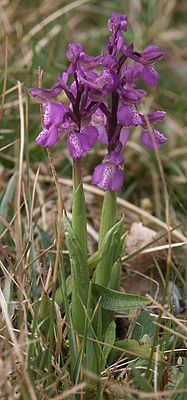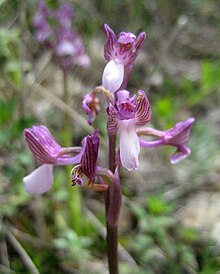Little orchid
| Little orchid | ||||||||||||
|---|---|---|---|---|---|---|---|---|---|---|---|---|

Orchid ( Anacamptis morio ) in the subspecies subsp. morio |
||||||||||||
| Systematics | ||||||||||||
|
||||||||||||
| Scientific name | ||||||||||||
| Anacamptis morio | ||||||||||||
| ( L. ) RMBateman, Pridgeon & MWChase |
The Small orchid ( Anacamptis morio (L.) RMBateman, Pridgeon & MWChase , Syn. : Orchis morio L. ), also Salep orchid , Satyrion , Stendelwurz or Narrenkappe called, is a plant of the genus anacamptis ( Anacamptis ) within the family of orchids (Orchidaceae).
Description and phenology
Vegetative characteristics
The orchid is a perennial , herbaceous plant that reaches heights of 8 to 50 centimeters. The leaves, which are usually in a basal rosette, are lanceolate, usually pointed, occasionally with a rounded tip, 3 to 10 centimeters long and about 1 to 2 centimeters wide. The stem is strong, somewhat angular and tinged with purple towards the top.
Generative characteristics
The inflorescence is usually profuse. The hermaphrodite flowers are zygomorphic and threefold. The flower colors are predominantly purple, but can also be almost white. The middle sepal and the petals form a helmet. The lateral sepals have a striking, green line pattern and protrude slightly. The lip is up to 10 millimeters long and 16 millimeters wide, weakly to moderately three-lobed. The side lobes are spread flat or folded back. The lip base is lighter with darker dots or line patterns. The cylindrical spur is curved upwards and - depending on the subspecies - shorter than the ovary or as long as the ovary.
The number of chromosomes is 2n = 36.



ecology
The orchid is a sham sap flower in terms of ecology because the spur does not contain any nectar . Since the orchid is self-sterile , it can not produce seeds without pollination of the flowers . The orchid is one of the first plant species to bloom in a meadow. It will appear at the end of April and in the Mediterranean area from March.
Distribution, locations and endangerment
Due to the diversity of the Orchis morio group, the distribution area is difficult to define. The orchid is a European floral element . Orchis morio in the narrower sense is common in Europe , North Africa , Western Asia to Iran and the Caucasus . Its area extends northwards to England , Scandinavia and the Baltic States ; the southern distribution area stretches from Portugal and northwestern Africa via Crete to Turkey .
It occurs sporadically in the lowlands of Central Europe and hardly rises above altitudes of 1500 meters in the Alps . In the Allgäu Alps, the Bayerstettener Köpfle near Nesselwang rises to an altitude of 1170 meters. According to Baumann and Künkele , the species has the following altitude limits: Germany 20–1130 meters, France 0–1800 meters, Switzerland 260–1950 meters, Liechtenstein 430–1500 meters, Austria 120–1600 meters, Italy in the Alps 1–1900 meters, Slovenia 10–1490 meters, Europe 0–1950 meters above sea level.
The orchid grows best on low -nitrogen , weakly acidic or slightly basic meadow soil that should not be permanently dry. It occurs on poor grassland , sometimes also on dry grassland , moderately moist meadows, drier areas of wet meadow and sparse forests. It needs unfertilized locations. In Central Europe it inhabits semi - arid grasslands and single-cut dry meadows as well as single-cut, short-grass, moist meadows . It is in Central Europe, a characteristic species of the association but Mesobromion comes also in dry societies associations Arrhenatherion or Molinion.
At its locations it sometimes occurs in larger, moderately dense, individual-rich stands. In the northern half of Germany , the orchid has only very few locations. Far more deposits have died out in the northern half of Germany than in southern Germany. Many sites were converted into fat meadows through fertilization and therefore destroyed.
The orchid is an orchid that was still very common in the 19th century. It hardly tolerates fertilization, but at least at times tolerates it a little more than, for example, the orchid orchid .
In order to point out the danger of this orchid, the green-winged orchid from was A rbeitskreis H egg mixer O rchideen (AHO) in Germany in 1991 for the orchid of the year selected.
Hybrids
The orchid ( Anacamptis morio ) hybridizes with closely related species such as the butterfly orchid ( Anacamptis papilionacea ), marsh orchid ( Anacamptis palustris ) and the pyramidal dogwort ( Anacamptis pyramidalis ).
Systematics
The first publication took place under the name ( Basionym ) Orchis morio by Carl von Linné . The specific epithet morio is derived from the Greek word moros for fool. The resemblance of the upper part of the flower to a fool's cap may explain this.
Since 1997 the orchid has been assigned to the genus Anacamptis as Anacamptis morio (L.) RMBateman, Pridgeon & MWChase .
One can distinguish the following subspecies:
- Anacamptis morio (L.) RMBateman, Pridgeon & MWChase subsp. morio : It occurs in Europe and grows at altitudes between 0 and 2000 meters above sea level.
- Albanian orchid ( Anacamptis morio subsp. Albanica (Gölz & HRReinhard) Kreutz , syn .: Orchis albanica Gölz & HRReinhard ): It occurs in Albania and perhaps also in Montenegro in coastal pine forests at altitudes between 0 and 1500 meters above sea level.
- Südkaukasisches Orchid ( Anacamptis morio subsp. Caucasica (K.Koch) H.Kretzschmar, Eccarius & H.Dietr. , Syn .: Orchis morio subsp. Caucasica (K.Koch) EGCamus ): It comes from the Balkan Peninsula to the northern Iran before and grows at altitudes between 0 and 1300 meters above sea level.
- Three-bulb orchid ( Anacamptis morio subsp. Champagneuxii (Barnéoud) H. Kretzschmar, Eccarius & H.Dietr. , Syn .: Orchis morio subsp. Champagneuxii (Barnéoud) EGCamus , Orchis champagneuxii Barnéoud ): It occurs in Morocco , Algeria , Portugal , Spain and France at altitudes between 0 and 1500 meters above sea level.
- Longsporn orchid ( Anacamptis morio subsp. Longicornu (Poir.) H. Kretzschmar, Eccarius & H.Dietr. , Syn .: Orchis morio subsp. Longicornu (Poir.) Kreutz , Orchis longicornu Poir. ): It comes from the western Mediterranean to Sicily and grows at altitudes between 0 and 2000 meters above sea level.
- Southern French-winged Orchid ( Anacamptis morio subsp. Picta (Loisel) Jacquet & Scappat.. , Syn .: Orchis morio subsp. Picta (Loisel) K.Richt.. , Orchis picta Loisel. , Anacamptis picta (Loisel) RMBateman. ): There occurs in Portugal, Spain, France, Corsica and Italy at altitudes between 0 and 500 meters above sea level. Occurrences in Algeria are questionable.
- Syrian orchid ( Anacamptis morio subsp. Syriaca (EGCamus) H. Kretzschmar, Eccarius & H.Dietr. , Syn .: Orchis morio subsp. Syriaca E.G.Camus , Anacamptis syriaca (EGCamus) RMBateman, Pridgeon & MWChase ): It comes from the southern one Turkey to Israel and Cyprus at altitudes between 0 and 1300 meters above sea level.
- Tlemcen Orchid ( Anacamptis morio . Subsp tlemcenensis . (Batt) Kreutz , Syn .: Orchis morio . Subsp tlemcenensis (Batt) EGCamus. , Orchis longicornu f. Tlemcenensis Batt. ): It comes in the northwestern Algeria and northern Morocco in the Phrygana and in light oak forests at altitudes between 700 and 1000 meters above sea level.
swell
literature
- Ruprecht Düll , Herfried Kutzelnigg : Pocket dictionary of plants in Germany and neighboring countries. The most common Central European species in portrait. 7th, corrected and enlarged edition. Quelle & Meyer, Wiebelsheim 2011, ISBN 978-3-494-01424-1 .
- Oskar Sebald, Siegmund Seybold , Georg Philippi, Arno Wörz (eds.): The fern and flowering plants of Baden-Württemberg. Volume 8: Special part (Spermatophyta, subclasses Commelinidae part 2, Arecidae, Liliidae part 2): Juncaceae to Orchidaceae. Eugen Ulmer, Stuttgart 1998, ISBN 3-8001-3359-8 .
Individual evidence
- ↑ Little Orchid. In: FloraWeb.de.
- ↑ a b Erich Oberdorfer : Plant-sociological excursion flora for Germany and neighboring areas . 8th edition. Stuttgart, Verlag Eugen Ulmer, 2001. ISBN 3-8001-3131-5 . Page 279–280.
- ↑ a b c d e Dietmar Aichele, Heinz-Werner Schwegler: The flowering plants of Central Europe . 2nd Edition. tape 5 : Swan flowers to duckweed plants . Franckh-Kosmos, Stuttgart 2000, ISBN 3-440-08048-X .
- ↑ Erhard Dörr, Wolfgang Lippert : Flora of the Allgäu and its surroundings. Volume 1, IHW, Eching 2001, ISBN 3-930167-50-6 , p. 364.
- ↑ Helmut Baumann , Siegfried Künkele : Orchidaceae . In: Oskar Sebald u. a .: The fern and flowering plants of Baden-Württemberg. 1st edition Volume 8, page 377. Verlag Eugen Ulmer, Stuttgart 1998. ISBN 3-8001-3359-8
- ↑ a b c d e f g h i Rafaël Govaerts (ed.): Anacamptis morio. In: World Checklist of Selected Plant Families (WCSP) - The Board of Trustees of the Royal Botanic Gardens, Kew . Retrieved November 27, 2016.
- ↑ a b c d e f g h i Helmut Baumann , Siegfried Künkele and Richard Lorenz: Orchids of Europe with adjacent areas . Verlag Eugen Ulmer, Stuttgart, 2006. ISBN 978-3-8001-4162-3 . Page 223–233.
Web links
- Little orchid . In: BiolFlor, the database of biological-ecological characteristics of the flora of Germany.
- Profile and distribution map for Bavaria . In: Botanical Information Hub of Bavaria .
- Thomas Meyer: Data sheet with identification key and photos at Flora-de: Flora von Deutschland (old name of the website: Flowers in Swabia )
- Distribution maps
- Distribution map for Germany. In: Floraweb .
- Switzerland (AGEO)
- Distribution in the northern hemisphere according to: Eric Hultén , Magnus Fries: Atlas of North European vascular plants 1986, ISBN 3-87429-263-0
- Regional
- The orchids of the Rhön: Anacamptis morio Little Orchid
- Orchids of Southern Styria Orchis morio Little orchid
- Anacamptis boryi inthe IUCN 2013 Red List of Threatened Species . Posted by: H. Rankou, 2011. Retrieved December 7, 2013.
- AGEO Switzerland: Orchis morio





